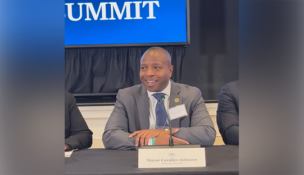UW professor probes drop in trials
By: dmc-admin//May 4, 2005//
 |
|
UW Law School Prof. Marc Galanter Photo by Tony Anderson |
Remember that scene in the movie "A Few Good Men" when Lt. Daniel Kaffe strolls into the majestic courtroom and says with self amazement "So this is what a courtroom looks like." It’s a sad but true announcement of the state of affairs in the adjudication of legal cases today.
Scholars have endeavored to divine the reason behind the decline of trials, but a voice from Wisconsin may have hit the nail on the head with astonishing clarity.
In the past several decades class actions, technology, regulation and legislation have made the fact questions quite apparently answerable, thus the need for answers on the law are all that are necessary to resolve many disputes.
As a result, we’ve seen the decline of jury trials in America.
Taking University of Wisconsin Law School Prof. Marc Galanter’s essay on the "Vanishing Trial" at face value, most practitioners agree there are fewer trials, more law practiced in the shadows and a growing segment of inexperienced litigators and judges.
Galanter not long ago unveiled a comprehensive study in which he chronicled a sharp decline in tried cases in this country. He found at the federal level, civil dispositions rocketed by a factor of five between 1962-2003 to 252,000 cases, but trials dropped by 27 percent during that time frame. There were peaks and valleys within that time span — trials hit a high in 1985 when 12,529 trials took place, but in the ensuing years trials dropped by almost two-thirds so that only 1.7 percent of cases are resolved at trial, down from 4.7 percent.
The activity in state courts mirrors the changes at the federal level. Since the mid-1970s jury trials dropped by a third and bench trials decreased 15.2 percent.
|
Percentage of Civil Terminations During/ After
Trial in U.S. District Courts, 1962-2002 |
 |
|
Source: Administrative Office of the United States Courts, Annual Report of the Director, Table C-4 (1962-2002)
|
One might presume criminal cases are the culprit, capturing all the court’s time, but those resolutions by trial have also dropped since 1976. Disposition of criminal cases grew by 127 percent in those same state courts, but jury trials declined by 15 percent and bench trials by 10 percent.
Galanter cites a number of reasons why jurors aren’t often called:
- Diversion of cases to alternative dispute resolution and administrative forums for adjudication.
- Costly litigation.
- Judicial officers strong-arming settlements.
- And most especially, trial trepidation caused by an unsubstantiated premise that juries are too generous.
Those all are affecting the arena, but a couple things not considered are the forbearers to today’s trial lawyers and technology. To be fair, there is no way even an empirical emperor like Galanter could hope to emphasize or prove these ethereal effects on the system, but a trial judge in Wisconsin, one who has been in the trenches for 17 years, has seen a past that has predestined the future. Big Tobacco, Fen Phen, pick your class case, the litigators of old got the job done, in spades, and now the warning labels are as long as your leg, the law’s written.
"During the hey day, when trials were peaking, my contention is partly that lawyers were particularly challenging many areas of the law, bringing lawsuits, class actions, tort reform, products liability, bringing new areas of law in civil litigation," said Barron County Circuit Court Judge Edward Brunner, who heads a group of presiding administrative district court judges. "But the landscape has changed."
All that litigation has forced new labeling of products, new warnings, new packaging.
"They made a lot of people change," he said. "They made our whole country change. Obviously corporations didn’t like that outcome but it worked didn’t it? As result, we have less litigation."
On the criminal side, Brunner, who admits he has a relatively small but not insubstantial docket, says video cameras and other virtual evidence makes fact finding in criminal cases — the backbone of the jury system — virtually obsolete. Plus, he says these days so many other lesser and or greater offenses are often charged so pleas are often pledged.
|
Civil Trials as Percentage of Dispositions in 22 State Courts of General Jurisdiction, 1976-2002
|
 |
|
Source: Ostrom, et al.
|
So are solicitors seeing the same things in the trenches? The answer is a resounding yes.
James Naugler, president of the Civil Trial Counsel of Wisconsin, the state’s defense bar, says he’s only guessing, but he’d have to say most lawyers’ trial practice has probably halved through the years, his included. He suggested it might even be greater than that percentage. Naugler agrees with Galanter’s findings on all fronts but the advent of increased ADR he believes ha
s probably had the biggest impact. And he says that is client driven.
"I would prefer to try cases, but if my client goes to mediation and they are satisfied with the outcome and they can save money and they can move on then that’s a good outcome," he said. "If the other party can save the cost of trying cases that’s good too. It’s very expensive to go to trial. If you want to underscore Galanter’s position that individual plaintiff’s don’t do all that well, look at medical malpractice. The attorney general’s estimate is around 25 percent, and my personal observation here in this part of the state is plaintiffs prevailing in medical malpractice is lower than 20 percent. At the same time the cost is extraordinary, it costs $50,000 to $100,000 just to sit at the table."
For once the two sides of the bar agree, to a degree. In contingent fee practice, Robert Habush, president of Habush Habush & Rottier S.C. in Milwaukee, who is a past president of the Association of Trial Lawyers of America, says it’s not the client’s money that’s on the line, it’s his.
"It’s your financial neck that you’re gambling with, it’s your risk, the lawyer’s risk," Habush said. "Now the client is not paying the cost and I don’t know what other lawyers do, but if we decide not to proceed with the case or it is not successful, we don’t go chasing the clients for the money."
Therefore, he says, lawyers have to be very cautious when they decide to go to trial, especially in light of med mal caps and tort reform, which have been a major driving force in the decline of trials. If you can settle for something close to what your client deserves, it’s probably best to do so.
But money isn’t everything. Galanter also pointed the finger at judges, accusing them of putting docket management ahead of justice. Another defense attorney, Bernard McCartan, who heads American Family Insurance Company’s litigation team in Wisconsin, agreed with that proposition.
"We find ourselves being pushed into mediation by judges who I think don’t want to try cases in some instances. In some instances mediation is not appropriate but the judges are pushing anyway," he said. "It’s time consuming, it’s more work. As a practical matter, they’ve got to sit there and pay attention, close attention to what’s going on for hours, even days at a time. That’s hard work. I don’t envy judges who have to do that. I would find it very difficult. Some of them, if they can avoid having to do it, they will."
However, Brunner quibbled with that contention, saying he and his fellow judges often lament the fact they don’t often get to preside over trials.
"As a judge, I would prefer to sit on civil trials, they are the most challenging, it’s an exciting part of the law, particularly when you don’t get to do it frequently," he said. "It’s a pleasure to delve into some juicy legal issues that come up in complicated civil litigation, and I miss it. This isn’t something that’s missed my colleagues, every time we get together we say, ‘What’s happening to your civil trials? Don’t you miss them?’"
On the criminal side, the Legislature is the animal that has gnawed away at trials. Veteran criminal defense attorney Waring Finke of West Bend says while the U.S. Supreme Court recently in Booker made federal sentencing guidelines advisory rather than mandatory, the damage has already been done.
"In the old days, under pre-sentencing guidelines, the federal government at least was much more tractable and able to carve out reasonable plea agreements," he said.
"That has gone away and as a result of the guidelines we’ve sort of shifted the balance of power to the prosecutor and away from the court. With mandatory minimum sentences and Congress in a headlong rush to get on the ‘Get tough on Crime’ bandwagon, it makes the stakes so much higher. If you can shave a few months off a sentence it makes no sense to go to trial."
He says Booker’s effects remain to be seen. But he and the civil litigators say something even scarier is happening in both bars. There aren’t many lawyers left who are willing and more importantly able to take matters to trial. It’s sort of a chicken and egg thing with fewer attorneys getting the opportunities, making them able to take the challenge.
And as a result of this series of unfortunate events, the justice system is rendered less just, Galanter says.
"This is not a good thing," he said. "The biggest problem is it means the whole process becomes more and more difficult and the quality of what they get instead declines. They get forced to choose something else and the alternative is not very attractive."
On the flip side, however, Brunner said he really has never heard anyone in the general public clamoring to get to court.
"I think there is a presumption here that litigation is good," Brunner said. "Do you ever talk to anybody that says, ‘Gee, I can’t wait to get to trial, I want my day in court.’ People say, ‘Can’t we settle this?’"
The legal population is not, however, ignorant of what’s at stake here and Habush and McCartan at least say they make a conscientious effort to get younger lawyers into the courtrooms, so trial experience doesn’t become extinct.
On an even broader plain, Los Angeles attorney Donna D. Melby, newly elected president of the American Board of Trial Advocates — an organization whose membership requirements are based on the number of trials people try — says they are undergoing an active campaign to alert the public to this awful advent.
"Civil jury trial is a fundamental guarantee given to us by the Bill of Rights. Which makes it pretty important to the founders because they put it in those first ten Constitutional amendments," she said. "Our founding fathers listed those things they deemed to be pretty important to our Democracy. The right to civil jury trial is critical. If we lose the right to civil jury trial it’s like a foundational beam being knocked away from a structure that’s based upon checks and balances."
Legal News
- Giuliani, Meadows among 18 indicted in Arizona fake electors case
- Some State Bar diversity participants walk away from program
- Wisconsin court issues arrest warrant ‘in error’ for Minocqua Brewing owner
- Iranian nationals charged cyber campaign targeting U.S. Companies
- Facing mostly white juries, are Milwaukee County defendants of color truly judged by their peers?
- Milwaukee Mayor speaks in D.C. Tuesday at White House water summit
- Chicago man sentenced to prison after being caught with ‘Trump Gun’
- FTC bans non-competes
- Gov. Evers seeks applicants for Dane County Circuit Court
- Milwaukee man charged in dismemberment death pleads not guilty
- Democratic-led states lead ban on the book ban
- UW Madison Professor: America’s child care crisis is holding back moms without college degrees
WLJ People
- Power 30 Personal Injury Attorneys – Russell Nicolet
- Power 30 Personal Injury Attorneys – Benjamin Nicolet
- Power 30 Personal Injury Attorneys – Dustin T. Woehl
- Power 30 Personal Injury Attorneys – Katherine Metzger
- Power 30 Personal Injury Attorneys – Joseph Ryan
- Power 30 Personal Injury Attorneys – James M. Ryan
- Power 30 Personal Injury Attorneys – Dana Wachs
- Power 30 Personal Injury Attorneys – Mark L. Thomsen
- Power 30 Personal Injury Attorneys – Matthew Lein
- Power 30 Personal Injury Attorneys – Jeffrey A. Pitman
- Power 30 Personal Injury Attorneys – William Pemberton
- Power 30 Personal Injury Attorneys – Howard S. Sicula











